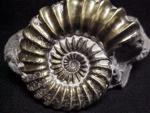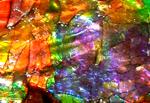Ammolite Info
Back to Ammolite
General
 |
| Ammonite with Ammolite Surface |
 |
| Ammonite |
Best, gemmy ammolites can be found within the Indian Kainah reserve in southern Alberta (Canada). Mines are along the St. Mary River, between Magrath and Lethbridge. "Korite International" is the first and largest in ammolite production (appr. 90% of the world production), supported by the local Kainah Indians who cooperates with "Korite International".
Approximately 50% of mined ammolite has gemstone quality. The ammolite deposits have several layers which are excavated in open pits: The "K Zone" layer is about 15 - 30 m below the surface, and contains less gemmy, crushed ammolites. The "Blue Zone" is 50 m below the surface, and is 15 m thick. It contains better gems which are less fractured.
Ammolite was recognized as a "semi-precious" gemstone until 1981. Then it was accepted as gemstone, and the commercial mining started. In 2004 ammolite became the official gemstone of Alberta and the town Lethbridge.
Ammolite Types
1. Natural Ammolites
A stone which has been left to its natural appearance. The host material (e.g. petrified clay or shale) is grinded off to a thin layer which stabilizes the iridescent ammolite surface. The gemmy ammolite layer is polished to a more or less flat surface. If the gem material is thick enough, one can create a rare two-sided ammolite.
Most natural stones are stabilized by pressing epoxy between the layers. This prevents the surface from splitting. Nevertheless ammolite should be used (worn) carefully, e.g. on special occasions but not as a ring.
2. Doublets, Triplets
Doublets are two connected pieces to create one stone: One thick, gemmy layer is sawn into slices, and can serve as thin surface for several new created ammolite doublets by connecting them with a new matrix (usually shale).
If a protective cap (made from transparent minerals like quartz or synthetic spinel or sometimes even opal) is attached to a doublet, the ammolite consists of three layers, and is called triplet. It is possible to create two-sided ammolites by glueing thin ammolite layers on both sides of a matrix, of course in combination with two additional caps.
If a gemmy ammolite has a cracked backing, doublets and triplets are the only way to preserve its beauty. Capped ammolite is harder than natural material. Therefore it can be used even as a ring. Of course caps can be faceted to enhance the appearance of a stone.
Treatments
Most natural ammolite is micaceous, and are stabilized by pressing epoxy between the layers. This prevents the surface from splitting, and is a widely accepted method.
The finest ammolites are just polished but don't need any coating. Coating should not be accepted because it misrepresents the lower value of a stone, and causes some problems over the time: Varnish is usally not designed for covering a mineral's surface, is too soft, can yellow or become cloudy, and allows water to get between the layers. That can result in a duller appearance. Scratches or other damages cannot be removed without destroying the coating.
If a coating is used, it protects the thin ammolite layer on the matrix from fading by too much sunlight exposure. Coated, lower quality stones appear wet, look more colorful.
Intensive colors of doublets or triplets can be caused by black (or other colors) epoxy between the ammolite layer and the matrix.
Patterns
Many ammolites have thinner or thicker black iron oxide (limonite) lines which can separate the colors, and cause the pattern of a stone.
There are a lot of names which stay for possible patterns of ammolites' surfaces: banded, checkerboard, cobblestone, desert, dragonskin, feather, flashfire, floral, foil, lava lamp, moonglow, paintbrush, pinfire, ribbon, ripples, sheet, stained glass, striped, and waves.
Ammolites with dragonskin-like patterns come from the "K-Zone", and are less worthy. They are found as rounded masses of minerals. The ammolite pieces are fractured, compacted, and cemented in petrified clay.
Ammolite from the "Blue Zone", the lower layer, has nearly no fractures, and must be stabilized. It shows sheet patterns, without lines, and is more valuable.
Grading and Value
Natural ammolite should not be priced per carat because of the weight of the natural matrix which necessarily belongs to the gemmy surface. A purchase per carat makes only sense if the backing (matrix) is 1.5 mm or thinner. But that is only possible if it is a doublet or a triplet.
Ammolite colors are not caused by refraction but result from thin aragonite platelets. Thick aragonite layers show red colors, thin layers show rare colors like rose, blue, and purple colors.
 |
| AA Ammolite |
AA: Best ammolites, showing at least three clear, good represented, brilliant colors in all (360°) directions.
A+: At least two clear, good represented, vivid colors which remain visible in nearly all (more than 240°) angles.
A: One or more clear, vivid colors which is / are visible in many (more than 180°) angles.
A-: Good color(s), not as vivid as in higher grades, partially disappearing when viewed from some (more than 90°) directions.
B: No good represented, dull colors which completely disappear at many angles.
C: Nearly no colors at many angles.
Free Grading
Rarity, appearance, and thus value is or can be a complicated matter of (often) subjective estimation. Especially re ammolite or precious opal one has to compare / grade a lot of different factors with different importance to a buyer. One prefers the full spectrum of colors, the other likes the brilliance and depth of just two colors, not to speak about the visibility from all angles, the size of a stone, the depth in which it was found (up to 65 m deep) etc.
One can decide which of the following factors are personally the most important ones:
1. Clear, vivid, brilliant, bright, extremely reflecting color(s)?
2. Full spectrum of colors?
3. Does the stone show rarer colors like pink, blue, violet? Red and green are common colors.
4. A good, possibly rare pattern?
5. Is there a color shifting like red into green or so? Is the shifting monochromatic (between different hues of one color), good (color shifting between two colors) or even spectacular (a color shifts through the full spectrum)?
6. Do colors extinguish if the stone is rotated
7. Does the ammolite show light flashes?
8. How about the depth of the colors (depending on the layer's thickness)?
9. Are there any flaws like cracks, "holes" in the surface layer, or bad treatment?
10. Do the colors fit to one's intentions (and / or the personal favorites)?
⇐ Intro Page ⇐ Gemstones ⇐ Ammolite